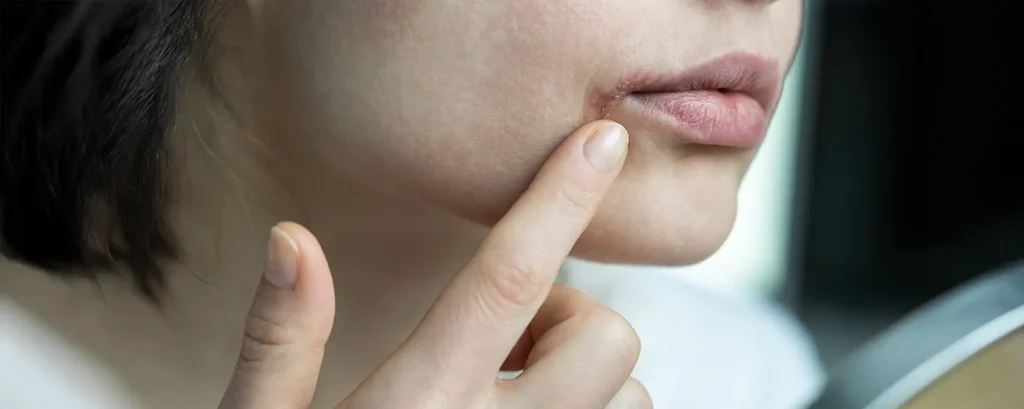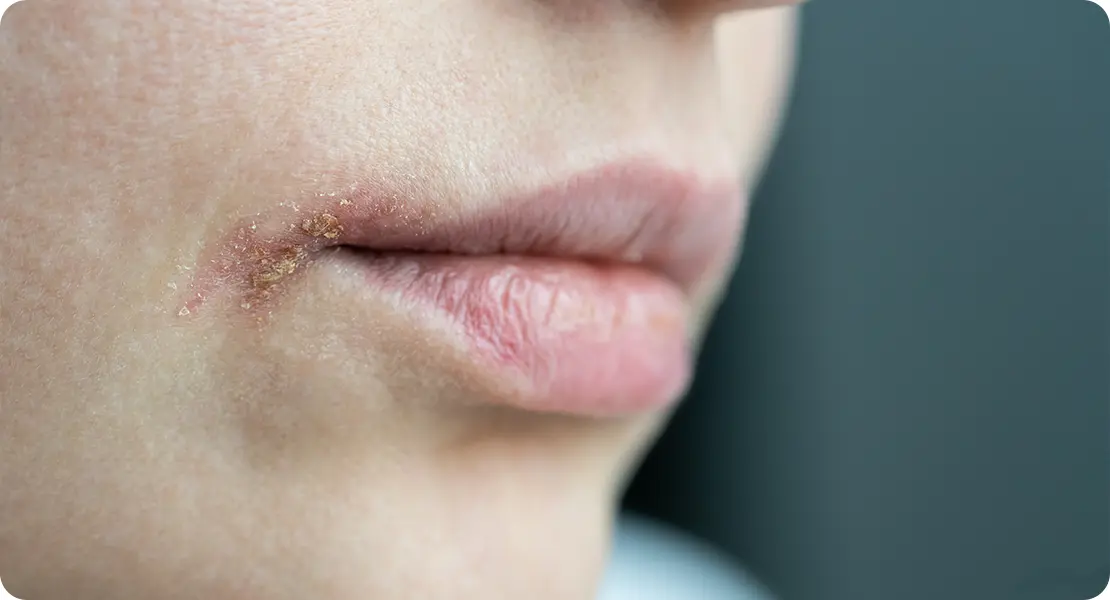If you’re someone who frequently gets cold sores and they always seem to appear in exactly the same place you’re not alone. Cold sores are incredibly common, affecting around two-thirds of adults worldwide. But their repetitive nature can be frustrating, especially when they flare up right before an event or during times of stress.
You might wonder, why does it always happen on that same spot on my lip? The answer lies in how the herpes simplex virus (HSV) behaves in your body after the first infection.
In this article, we’ll explore why cold sores reappear in the same place, what triggers them, and what you can do with the help of a dermatologist to manage outbreaks more effectively and heal faster.
What Are Cold Sores?
Cold sores, also known as fever blisters, are small, fluid-filled blisters that typically form on or around your lips. They’re caused by the herpes simplex virus type 1 (HSV-1), though type 2 (HSV-2), which usually causes genital herpes, can sometimes affect the mouth too.
Once you’ve been infected with HSV, it stays in your body for life. That doesn’t mean you’ll always have symptoms in fact, the virus spends most of its time dormant. But certain triggers can “wake it up,” causing cold sores to reappear.
Why Cold Sores Keep Coming Back to the Same Spot

One of the most frustrating things about cold sores is their predictability. Many people notice that their outbreaks occur on the same patch of lip or skin every single time.
The reason lies in how the herpes virus behaves after the first infection.
After your initial outbreak, HSV travels along sensory nerve fibres to a cluster of nerve cells known as the trigeminal ganglion, located near your ear. There, the virus becomes dormant meaning it’s inactive but still alive.
When the virus is reactivated by certain triggers (like stress, illness, or sunlight), it travels back down the same nerve pathway to the skin, usually emerging in the same area as before.
Because it follows this specific nerve route, your cold sores tend to reappear in familiar spots.
The Science Behind Dormancy and Reactivation
To understand recurring cold sores, it helps to know how the herpes simplex virus cycles between dormancy and activity.
Phase 1: Initial Infection
- The virus enters through tiny breaks in your skin or mucous membranes (often through kissing or sharing utensils).
- Your body responds with inflammation, redness, and blisters.
- After a few days, the sores crust over and heal.
Phase 2: Latency
- Once healed, the virus retreats into nearby nerve cells.
- It hides in the trigeminal ganglion, where your immune system can’t fully reach it.
- Here it remains inactive sometimes for months or even years.
Phase 3: Reactivation
- When your immune defences drop or certain triggers occur, the virus “wakes up.”
- It travels down the same nerve to the surface of your skin, where it replicates and causes a new blister.
This is why you often feel a tingling or burning sensation in the same place just before an outbreak your early warning sign that the virus is active again.
Common Triggers for Cold Sore Recurrence
While everyone’s triggers are different, several well-known factors can reactivate the herpes virus and lead to a flare-up.
1. Stress
Emotional or physical stress weakens your immune system, allowing the virus to resurface. Whether it’s work pressure, lack of sleep, or emotional strain, stress is one of the most common triggers.
Try relaxation techniques like deep breathing, yoga, or short walks to manage stress levels.
2. Illness or Fever
Cold sores often appear when your body is fighting another infection like a cold or flu. This is where the name “fever blister” comes from. When your immune system is busy elsewhere, HSV can take advantage of the opportunity to reactivate.
3. Sunlight and UV Exposure
Too much sun can trigger outbreaks, especially on the lips. Ultraviolet (UV) radiation can damage skin cells and reduce local immunity, giving the virus a chance to flare up.
Always apply a lip balm with SPF 30 or higher before going outdoors, even on cloudy days.
4. Hormonal Changes
Many women experience cold sore flare-ups during menstruation, pregnancy, or menopause. Hormonal fluctuations can alter immune response and trigger viral activity.
Keeping your immune system supported through proper sleep and nutrition can help reduce the frequency of these outbreaks.
5. Fatigue
Lack of sleep lowers your immune defences and can contribute to cold sore recurrence. Aim for at least 7–8 hours of quality sleep to help your body maintain its natural virus-fighting abilities
6. Injury or Irritation
Anything that irritates your lips such as dental procedures, dry lips, or even harsh weather can activate the virus. The skin’s barrier becomes compromised, making it easier for HSV to resurface in that spot.
7. Weak Immune System
People with weakened immune systems, such as those with autoimmune diseases or undergoing chemotherapy, may experience more frequent and severe outbreaks. In such cases, antiviral medication may be prescribed for long-term suppression.
Stages of a Cold Sore Outbreak

Cold sores typically follow a predictable cycle lasting 7–10 days.
- Tingling or itching (Day 1): A telltale sign that an outbreak is beginning.
- Blister stage (Days 2–3): Small, fluid-filled blisters form.
- Ulcer stage (Days 3–4): The blisters break, leaving shallow open sores.
- Crusting (Days 5–7): The sores dry out and form scabs.
- Healing (Days 7–10): The scabs fall off, and the skin heals completely.
Starting treatment early ideally at the tingling stage can help shorten the outbreak and make it less severe.
How to Reduce the Frequency of Cold Sores
While there’s no cure for herpes simplex, there are effective ways to reduce how often flare-ups happen and how long they last.
1. Identify Your Triggers
Keep a diary to note when outbreaks occur and what might have preceded them stress, illness, sun exposure, or diet. Recognising your personal triggers makes prevention much easier.
2. Manage Stress
Relaxation techniques like meditation, exercise, or simply taking regular breaks can strengthen your immune response and reduce recurrence.
Even 10 minutes of mindfulness a day can lower cortisol (the stress hormone) and help prevent flare-ups.
3. Protect Your Lips from the Sun
Use a lip balm with SPF every day, and reapply it frequently when outdoors. UV protection is one of the simplest yet most effective defences against cold sore recurrence.
4. Boost Your Immune System
A strong immune system helps keep HSV dormant. You can support yours by:
- Eating a diet rich in fruits, vegetables, and lean proteins.
- Getting enough sleep.
- Staying hydrated.
- Taking zinc and vitamin C if you’re prone to frequent colds.
5. Use Antiviral Treatments
Your dermatologistmay recommend antiviral medications such as aciclovir, valaciclovir, or famciclovir.
These can be taken as tablets during an outbreak or as a daily suppressive treatment if you experience frequent flare-ups (more than six times a year).
Topical antiviral creams, when applied early, can also speed up healing and reduce discomfort.
6. Keep Lips Moisturised
Dry, cracked lips can make it easier for the virus to reactivate. Keep your lips hydrated with a non-irritating balm or ointment especially in cold or windy weather.
Avoid sharing lip products to reduce the risk of reinfection or spreading the virus.
7. Maintain Hygiene During Outbreaks
When you have an active cold sore, it’s contagious. To prevent spreading the virus:
- Avoid kissing or oral contact.
- Don’t share utensils, towels, or lip products.
- Wash your hands frequently.
- Avoid touching your eyes, as HSV can cause serious eye infections.
Can Cold Sores Spread to Other Areas?
Yes though it’s rare. The virus can spread to other areas of your face or body if you touch an active sore and then another part of your skin without washing your hands.
This condition is called autoinoculation. It’s why hygiene during outbreaks is so important.
When to See a Dermatologist
While most cold sores heal on their own, recurring or severe outbreaks may need professional management. You should see a dermatologist if:
- You get cold sores more than six times a year.
- The blisters spread beyond your lips or into your nose or eyes.
- You have a weak immune system.
- The sores don’t heal within two weeks.
A dermatologist can help confirm the diagnosis, rule out other conditions (like impetigo or eczema herpeticum), and recommend personalised treatment.
Long-Term Suppression Therapy
If you experience frequent outbreaks, your doctor may suggest long-term antiviral therapy. This involves taking medication daily for several months to keep the virus inactive.
Studies show that suppressive therapy can reduce outbreaks by up to 80% and when they do occur, they’re typically milder and heal faster.
Home Remedies That Can Help
While antiviral medication is the most effective option, some home remedies can help ease discomfort and support healing:
- Cold compress: Apply a clean, cool cloth to reduce swelling and itching.
- Aloe vera gel: Has antiviral and soothing properties.
- Lemon balm (Melissa officinalis): Known for its antiviral effects against HSV.
- Petroleum jelly: Keeps the area moisturised and prevents cracking.
- Avoid acidic foods: Like citrus fruits and tomatoes, which can irritate the sores.
Always patch-test any topical treatment first, and avoid applying harsh or alcohol-based products to active sores.
Why You Might Get More Frequent Cold Sores
If your outbreaks seem to be increasing, it could be due to several factors:
- Ongoing stress or poor sleep.
- New medications that weaken your immune response.
- Hormonal changes.
- Uncontrolled medical conditions (like diabetes).
- Age-related immune decline.
If you notice a pattern of more frequent flare-ups, speak to your dermatologist for a review.
How Long Do Cold Sores Stay Contagious?
Cold sores are contagious from the moment you feel the tingling sensation until the blister is completely healed. That usually lasts about 7–10 days.
Even if the sore has scabbed over, the virus can still be spread through close contact. Waiting until the skin has fully healed before kissing or sharing items is always safest.
Can You Prevent Cold Sores Altogether?
There’s currently no cure for herpes simplex, but it is possible to keep outbreaks minimal or even prevent them altogether.
Consistent antiviral treatment, sun protection, and good lifestyle habits can dramatically reduce recurrence. Many people go months or years without a flare-up once they identify and manage their triggers.
Myth vs Fact: Understanding Cold Sores
You might have heard some common myths about cold sores, but let’s set the record straight.
First, many people think that only those with poor hygiene get cold sores. That’s not true. Cold sores are caused by a virus called HSV hygiene has nothing to do with it.
Another misconception is that once you have HSV, you’ll always have visible sores. In reality, the virus can stay dormant in your body for long periods, so you might not always see an outbreak.
Some believe you can’t spread cold sores unless a sore is visible. However, the virus can still be active and contagious even when you don’t see any symptoms.
Lastly, a lot of people worry about catching cold sores from surfaces. HSV actually dies quickly outside the body, so you typically need direct contact to pass it on.
Understanding these facts can help reduce stigma and guide you toward proper management of cold sores.
Protecting Others from Cold Sores
If you live with others or have young children, take extra care during outbreaks. HSV can be dangerous for newborns and people with compromised immunity.
- Avoid kissing babies or sharing utensils.
- Keep sores clean and covered if possible.
- Wash pillowcases and towels frequently during outbreaks.
Being cautious helps prevent spreading the virus to loved ones.
FAQs:
1. Why do cold sores always appear in the same spot?
Cold sores tend to recur in the same area because of the way the herpes simplex virus behaves in your body. After your first infection, HSV travels along sensory nerves to a cluster of nerve cells called the trigeminal ganglion, where it becomes dormant. When the virus is reactivated, whether by stress, illness, or sun exposure, it travels back along the same nerve pathway to the surface of your skin. This is why you often notice outbreaks in the same familiar spot on your lips or around your mouth.
2. How long do cold sores typically last?
Cold sores usually follow a predictable timeline. They often start with tingling or itching, followed by fluid-filled blisters that may break and form shallow sores. Over the next few days, these sores crust over, eventually healing completely. For most people, this entire cycle takes around 7 to 10 days, though starting treatment early can help speed up healing and reduce discomfort.
3. Can stress really trigger a cold sore outbreak?
Yes, stress is one of the most common triggers for cold sores. Emotional strain, work pressure, or physical stress like illness can weaken your immune system, giving the virus an opportunity to reactivate. Even short periods of high stress can provoke a flare-up, which is why managing stress with relaxation techniques or mindfulness can make a noticeable difference in preventing outbreaks.
4. Are cold sores contagious even if I don’t see a blister?
Absolutely. The herpes simplex virus can be active and shed from your skin even when there’s no visible sore. This is why cold sores can still be spread through close contact, like kissing or sharing utensils, even if you don’t have a current outbreak. Being aware of this helps prevent accidental transmission to others.
5. Can cold sores spread to other parts of my body?
It’s possible, though uncommon, for HSV to spread to other areas of your body. This usually happens when someone touches an active cold sore and then touches another part of their skin without washing their hands. This process, known as autoinoculation, can lead to sores appearing in places like the eyes or fingers, which is why hygiene during outbreaks is so important.
6. How can I reduce the frequency of cold sore outbreaks?
While there’s no cure for HSV, you can take several steps to reduce flare-ups. Identifying personal triggers like stress, sun exposure, or fatigue helps you prevent reactivation. Supporting your immune system through proper sleep, nutrition, and hydration is also essential. Using a lip balm with SPF, applying antiviral treatments early, and maintaining good hygiene can all contribute to fewer and milder outbreaks over time.
7. Are antiviral medications effective for managing cold sores?
Yes, antiviral treatments like aciclovir, valaciclovir, or famciclovir are very effective. These medications can be taken during an outbreak to shorten its duration and reduce severity. For people with frequent flare-ups, daily suppressive therapy may be recommended to prevent outbreaks altogether. Topical creams can also help relieve discomfort if applied as soon as tingling or itching begins.
8. Can lifestyle changes really make a difference?
Lifestyle choices can have a significant impact on cold sore recurrence. Managing stress, getting adequate sleep, eating a balanced diet, and staying hydrated all support your immune system, which keeps the virus dormant for longer. Avoiding lip irritation, protecting your lips from UV exposure, and practising good hygiene during outbreaks are simple yet effective strategies to reduce the likelihood of flare-ups.
9. When should I see a dermatologist about cold sores?
You should consult a dermatologist if you experience frequent outbreaks, such as more than six times a year, or if sores spread beyond your lips or into your nose or eyes. It’s also important to seek professional advice if you have a weakened immune system or if sores don’t heal within two weeks. A dermatologist can provide personalised treatment, including antiviral therapy, and help rule out other skin conditions that may mimic cold sores.
10. Is it possible to prevent cold sores entirely?
Currently, there’s no way to completely eradicate HSV from your body, so prevention focuses on keeping outbreaks to a minimum. Consistent antiviral therapy, protecting your lips from the sun, and maintaining strong immune health can dramatically reduce recurrence. Many people find that once they identify and manage their personal triggers, flare-ups become infrequent, and some even go months or years without a single outbreak.
Final Thought: Take Control of Your Cold Sores with Expert Guidance
Recurring cold sores can be frustrating, but knowing why they appear in the same spot and what triggers them can help you manage outbreaks more effectively. By identifying your personal triggers, protecting your lips, maintaining a strong immune system, and using antiviral treatments when needed, you can reduce both the frequency and severity of flare-ups.
If you would like to book a consultation with one of our dermatologists, you can contact us at the London Dermatology Centre to receive personalised advice and treatment tailored to your needs. Our team will guide you every step of the way to help keep your skin healthy and flare-up free.
References:
1. Bae, E.B., 2024. Recurrent herpes infection showing a new facial phenotype. Journal of Clinical Dermatology, 12(3), pp. 45-52. Available at: https://pmc.ncbi.nlm.nih.gov/articles/PMC11238776/
2. Fetriani, U., 2025. Identifying the multifactorial triggers of monthly recurrent herpes simplex virus infections. Journal of Infectious Diseases, 58(2), pp. 123-130. Available at: https://pmc.ncbi.nlm.nih.gov/articles/PMC12306561/
3. Usatine, R.P., 2010. Nongenital herpes simplex virus. American Family Physician, 82(9), pp. 1075-1082. Available at: https://www.aafp.org/pubs/afp/issues/2010/1101/p1075.html
4. Lafferty, W. E., et al. (1987). Recurrences after oral and genital herpes simplex virus infections. Journal of Infectious Diseases, 156(2), 206–210. Available at: https://pubmed.ncbi.nlm.nih.gov/3033506/
5. Baringer, J. R. (1976). The biology of herpes simplex virus infection in humans. Journal of Infectious Diseases, 134(6), 662–667. Available at: https://pubmed.ncbi.nlm.nih.gov/185737/
